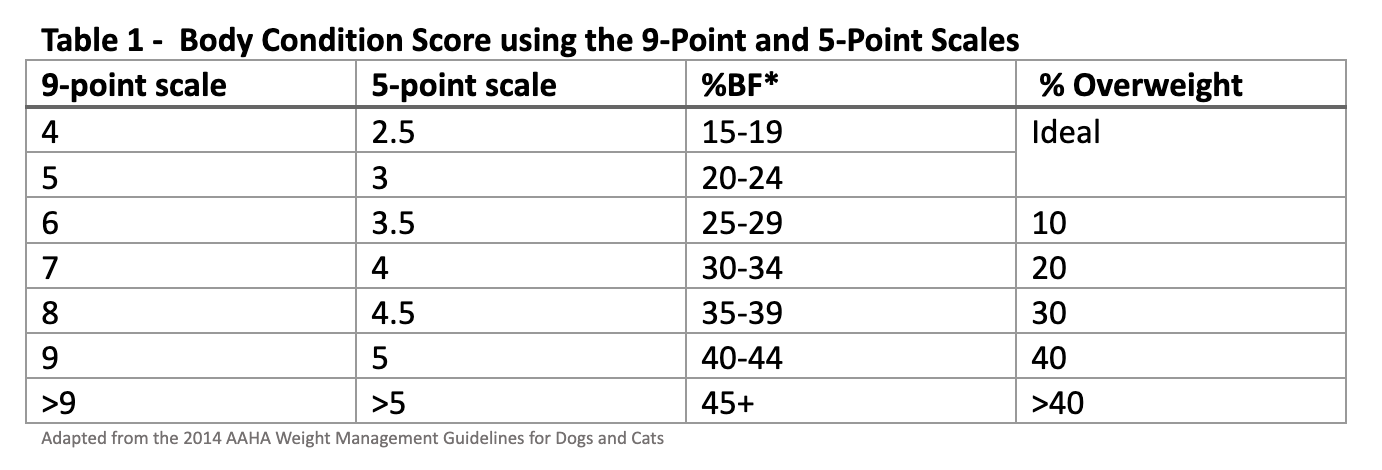
Managing Obese Patients in the Vet Practice
Introduction
Being overweight is the most common nutritional problem in both dogs and cats with a total of 59% being diagnosed with this disorder. 1 Of those animals classified with being overweight 39% of owners do not believe and rather see their pets at an acceptable size.2 Therefore, transparent vet-client communication is essential to prevent further disorders associated with excess weight. Some of which include diabetes mellitus, respiratory disorders and even some cancers. Studies that evaluate weight management of pets often do not differentiate between being obese and being overweight, however, it is noted that an increase in weight and thus body fat, increases the risks of developing consequential diseases. Through prevention, assessments and follow-up weight loss and exercise programs, pets diagnosed with obesity can be adequately managed.
Prevention
The first step to manage overweight and obese patients is to proactively assess weight at every veterinary visit beginning from the very first. Dietary requirements also change according to age, energy expenditure (includes metabolic rate and physical activity), skeletal maturity and neutering status.1 In terms of age, puppies and kittens need to maintain an adequate intake of nutrients to aid in growth. However, if neutered, there needs to be management surrounding caloric intake since their appetite may increase while their caloric needs decrease. Similarly, adult food should only be introduced after skeletal maturity. Additionally, anything that decreases energy expenditure, such as reducing exercise due to age or extreme weather conditions or even aging may need to result in a less caloric-dense diet.
Therefore, recommendations should be given for:- Puppy and kitten feeding - e.g. switching to a low-calorie diet post-neutering since appetite will increase whilst caloric requirements decrease
- Adjusting feeding according to a Body Condition Score - e.g. if a body condition score is above 5, switching to a canned food diet which is low in calories and proportioned would be ideal
- Maintaining exercise and an ideal weight - e.g. have a set target of 15min walks every day for a week and then increase this time as the pet gets fitter
- Interactive awards over food as a reward in relation to behaviour training - e.g. offering affection over a treat
Initial Assessment
The initial assessment is divided into two parts the screening evaluation and the extended evaluation.3 The screening evaluation involves assessing the pet and their body and muscle condition score. This is performed on all pets. If there are any abnormalities based on this test, an extended evaluation is performed to assess the client's feeding management, the current diet and any current health related disease that may be affecting body weight. A nutritional assessment checklist should be filled out along-side the screening and extended evaluation to confirm that all parts of the assessment have been completed. The pet owner should complete sections relating to diet and current activity levels whilst the veterinarians or vet nurses will fill out the rest with the evaluations they have made during the assessment.
Screening Evaluation - Assess the Patient
This involves a physical exam as well as laboratory and imaging studies to accurately assess the patient's physical condition. The main aspect of this part is to evaluate the pet's body weight, body condition score (BCS) and muscle condition score (MCS). Even if pet is overweight or obese they may still have significant muscle loss. This means that BCS and MCS do not have a direct relationship, however, an evaluation of both allows an accurate weight loss program.3 Likewise, the BCS and MCS can be compared to previous measurements to adjust client feeding, management and diet accordingly.
Body Condition Score
Body Condition Score is used to measure the relationship between the body fat and body weight of a canine or feline. BCS score is given out of 5 or 9 where 2.5-3/5 or 4-5/9 are ideal.4 This score is determined qualitatively by physically and visually assessing the waist and ribs of the pet and then correlating the outcomes with a score. From this score, the ideal body weight can be calculated using the following equation1
ideal body weight=current body weight x (100-%BF*)/0.8** *%BF is the % body fat that correlates with the given BCS score **0.8 represents that lean mass should be around 80%

Muscle Condition Score
Muscle Condition Score evaluates the muscle mass in a pet by visually and physically examining the animal. Performing palpitations over the temporal bones, scapular, ribs, lumbar vertebrae and pelvic bones is necessary to determine the level of muscle wastage.3 The deeper the compression, the more muscle has been lost. The MCS is divided into four categories; normal muscle mass, mild muscle wasting, moderate muscle wasting and marked muscle wasting.
Extended Evaluation - Assess Disease/Disorder-related Factors
This involves assessing for any changes in behaviour or any loss of the integument. Additionally, check for any current medical conditions which can be causing a gain in weight or similarly any medications that can cause malabsorption of nutrients.1 Tests may be administered to more critically analyse the nutritional status. To determine if it is internal or external factors affecting weight gain.
Extended Evaluation - Assess Current Diet
Diet history is important to evaluate the nutritional status of the pet. This includes how many times a day the pet eats, any treats provided, chews and supplements. If treats exceed 10% of the total daily diet it is assumed that there will be a nutritional imbalance. Noting down the total calorie input can help shape the new diet and how food and feeding alternatives can be administered.
Extended Evaluation - Assess Current Client Feeding and Management
A diet can only be administered by the client therefore it is essential to remain transparent and clear with them when discussing a new feeding plan. In order to get to this phase, assess the client's eagerness and ability to comply with recommendations.
Design a Weight Loss program

- Using the body conditions score and the correlated % body fat, the ideal body weight can be determined
- Determining caloric intake restrictions must be tailored to the patient by assessing their metabolism and target body weight One method is to feed only 80% of the current caloric intake An alternative method is to calculate the resting energy requirement for the patient using the equation below1 RER [kcalday]=70 x (ideal body weight kg)0.75
- Diet selection should be based on caloric restriction as well as pet and client preference. Macro- and micronutrient needs must be considered on top of wet versus dry food and measurements of either. Draw up a list of different diet plans and determine with the client what would work best for the pet.
- An exercise plan can be established by taking into consideration the prior steps in a weight loss program. Also, to be considered is who will be involved in the exercise plan and how it will be documented. Any comorbidities must also be assessed in order to adapt a physical activity program. A rehabilitation therapist may also need to be involved depending on the health of the pet. Caloric intake with an adequate exercise plan can increase the chance of a successful weight loss.1
- Ensure and enforce weight loss programs in maintained by providing follow-up assessments. This can be either providing an electronic reminder system to clients, or pro-active follow-up calls to clients. Additionally, during the initial plan of the weight loss program, determine when a pet should reach a particular target or when another check-in is needed. At this check-in record any improvements or downturns and discuss open-mindedly with the client about how they should now adapt the weight loss programs whilst also considering their concerns.
Ongoing Weight Assessments
The success of a weight loss program can be determined on how enthusiastic a vet team is about recommending it to their clients. Therefore, vet teams must all have acquired some knowledge on how to encourage clients to adopt and continue this program. Firstly, providing information about diet requirements at various life stages everyone on the veterinary team needs to be up to date on this information. Some vets or vet nurses can be assigned to do some follow up calls checking in on the weight loss progression and also to provide advice on issues that may negatively affect the set program. Recommend group programs to attend or any that the vet clinic is running to help with maintaining exercise. Clients should be contacted at in 2-week intervals after initial assessment until ideal body weight is achieved to encourage and ensure that a weight loss regimen in achieved
References:
Brooks D, Churchill J, Fein K, Linder D, Michel KE, Tudor K, Ward E, Witzel A; American Animal Hospital Association. 2014 AAHA weight management guidelines for dogs and cats. J Am Anim Hosp Assoc. 2014 Jan-Feb;50(1):1-11. doi: 10.5326/JAAHA-MS-6331.
White GA, Hobson-West P, Cobb K, et al. Canine obesity: is there a difference between veterinarian and owner perception? J Small Anim Pract 2011;52(12):622-6. doi: 10.1111/j.1748-5827.2011.01138.x.
Baldwin K, Bartges J, Buffington T, Freeman LM, Grabow M, Legred J, Ostwald D Jr. AAHA nutritional assessment guidelines for dogs and cats. J Am Anim Hosp Assoc. 2010 Jul-Aug;46(4):285-96. doi: 10.5326/0460285.
Bjornvad CR, Nielsen DH, Armstrong PJ, McEvoy F, Hoelmkjaer KM, Jensen KS, Pedersen GF, Kristensen AT. Evaluation of a nine-point body condition scoring system in physically inactive pet cats. Am J Vet Res. 2011 Apr;72(4):433-7. doi: 10.2460/ajvr.72.4.433.